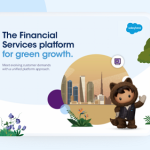Marketforce Roundtable: How can banks meet rising customer expectations and compete in an age of technological innovation?
Marketforce and Salesforce recently hosted a roundtable on changing customer expectations in banking. The virtual event featured experts from across the industry: Cashplus CEO Rich Wagner, Salesforce’s Regional Sales Director Financial Services UKI Alice Steels, and Salesforce’s RVP, Strategic Banking, Sean Gregan.
Each attendee shared how banking can move towards integrated, immediate, and value-adding customer experiences.
Missed the event? That’s OK. We’ve rounded up some of the most interesting talking points.
How Cashplus aims to meet rising customer expectations in banking services.
Rich Wagner opened up the discussion with an inspiring speech about his work as CEO at Cashplus.
Rich likes to think of Cashplus as a neo-challenger bank. Cashplus was the first to offer a general-purpose prepaid card in the UK. This particularly appeals to the unbanked — an audience Rich was part of when he first moved to the UK.
Meeting rising customer expectations is part of Cashplus’ business ethos. Colleagues are aware that customers are ‘the ones paying salaries’. This is to create an organisation that is customer-centric from top to bottom. As Rich says himself, “Giving a voice to the customer is a key focus of the business”.
But Cashplus is aware of the risk of taking a short-term view when it comes to pleasing customers. Fast and frictionless journeys can delight them. But if businesses get too hung up on speed above anything else, it can be detrimental in the long run. Cashplus believes all stakeholders need to be happy — including the board, investors, and even the regulator.
During his talk, Rich stressed that regulators are a friend, not a foe. Although they need education too. For example, there is tension surrounding “Buy Now Pay Later”. It’s what customers want but is it the responsible service the regulator wants? It’s important to have checks and balances between both parties.
Furthermore, Rich highlighted that some digital challenger banks are losing money. This is untenable and is why you cannot only focus on customer needs. You need to build for the future to continue to engage customers.
Rich closed his speech by reminding everyone not to make assumptions about what customers want. Data and analytics are more important than what they say they want. You need to monitor behaviour to make sure you’re meeting real needs, not following trends.
The role of digital in meeting customer expectations in banking.
Customers expect digital to be part of their banking experiences. This has evened out the playing field and put the customer in charge. As Rich Wagner said, customers are now the ones paying the wages.
In the past, banking focused on making money no matter what service they were providing. New digital challengers have created a huge shift across the industry over the last five years. The focus has changed from products to customers. Now, the need to deliver digital customer journeys is part of most banking companies’ cultures. There is also a big focus on satisfaction measured via Net Promoter Score (NPS) surveys.
Technology is helping banks to understand customer needs as well as meet them. As discussed by Rich Wagner, data and analytics are key. Machine learning helps banks to understand the difference between what customers say they want and their actual behaviour. For example, you can use credit data to analyse the differences between customer research and real-life spending. Technology in banking gives product teams the insights they need to inform the products they offer. For example, banks can use data to encourage behaviours such as inviting users to move onto other services and channels.
Meeting the expectations of the non-digital savvy customer in banking.
While many people like digital interactions, a sizeable audience is not yet digitally confident (and may never be).
These non-digital savvy customers still have high expectations. They expect to receive great customer service via their chosen channels. So, how can you give a customer who is not digitally savvy a good experience?
Digital still has a role to play. You can use analytics to segment customers and identify the best channel to serve them. A more hands-on approach involves joining a call centre for a day. This is a great way for teams to understand real customer needs.
Human help must be still available. Digital is not desirable for a core proportion of a bank’s customer base. Did you know that over 40% of transactions are still in cash? Speaking to a person and accessing in-person banking services is invaluable to many.
Salesforce for banking.
The Marketforce and Salesforce roundtable event explored various topics, including how to please every customer — digitally savvy, or not.
For more industry-specific insights, you’ll find webinars, reports, guides and more in our financial services resource centre.
Salesforce is here to help banks meet — and exceed — customer expectations. Our powerful Customer 360 platform helps banks deliver customer-centric journeys. To find out more about how Salesforce can help your banking business, visit our Salesforce for banking page.
























